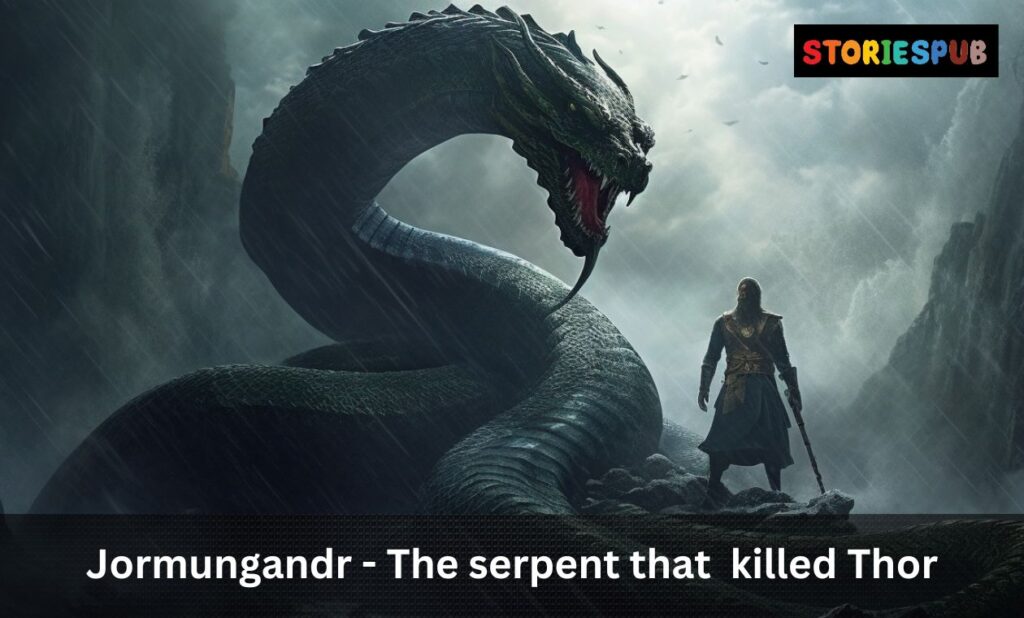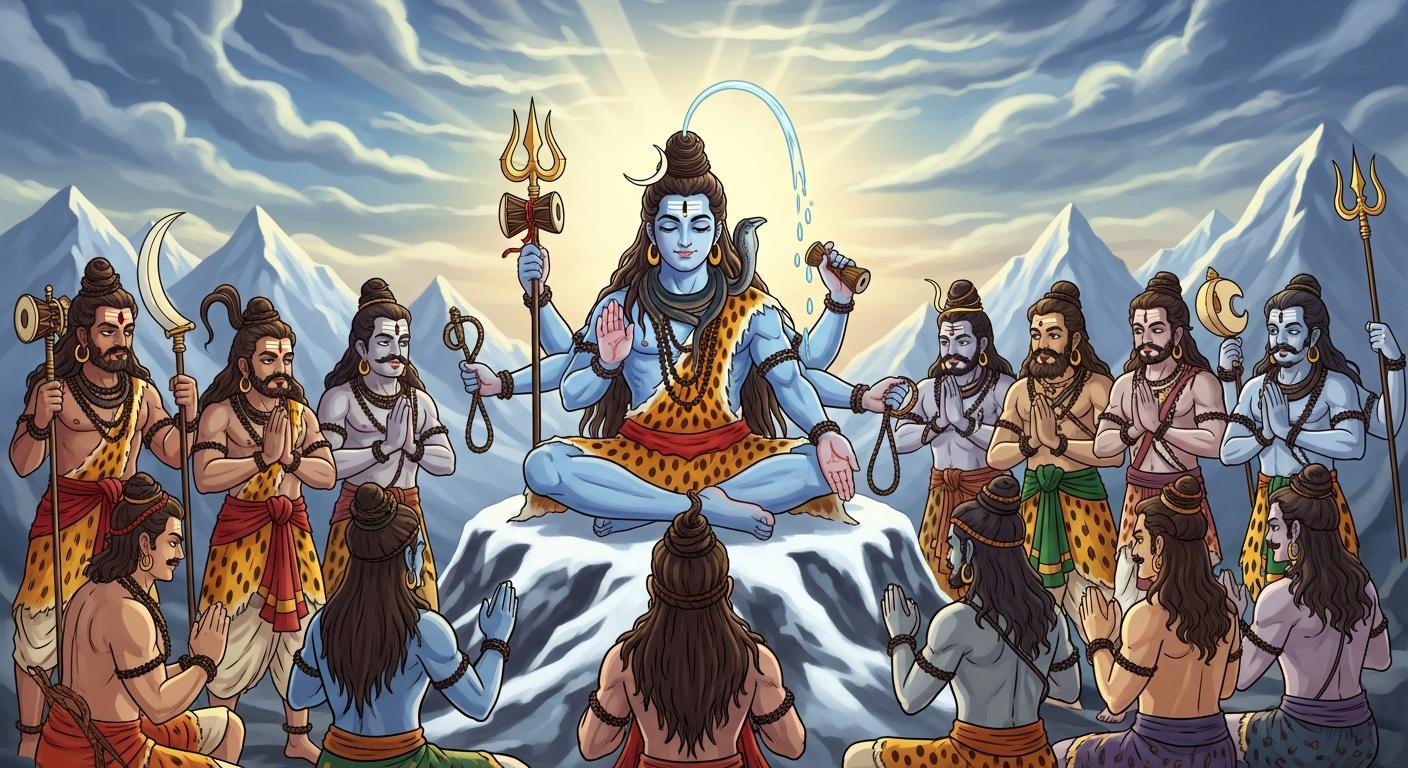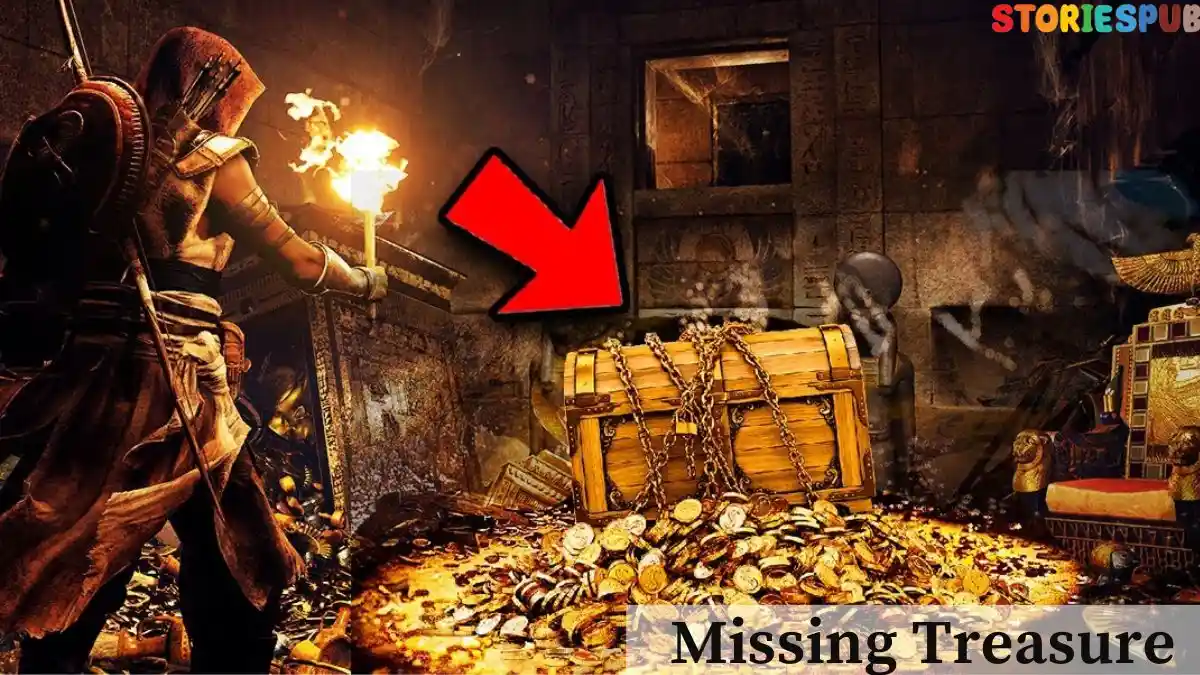Summarize this Article with:
Jormungandr – The serpent that encircles Midgard and killed Thor

Introduction
Norse mythology is rich in fantastical creatures, gods, and epic battles. One of the most fascinating creatures in Norse mythology is Jormungandr, the serpent that encircles Midgard, the world of humans. In this article, we will explore Jormungandr’s birth, its significance in Norse mythology and its role in the fate of some of the greatest gods.
Brief Overview of Norse Mythology
Norse mythology is a collection of tales originating from ancient Scandinavian culture. It consists of stories about gods, goddesses, giants and various other supernatural beings.
These stories were passed down orally for generations until they were eventually written down during the Middle Ages. Norse mythology holds that there are nine worlds bound together by a great tree called Yggdrasil.
These worlds include Asgard (the home world of the gods), Midgard (the world of humans), and Helheim (the realm of the dead). According to legend, these worlds are connected by Yggdrasil’s branches and roots.
Introduction to Jormungandr
Jormungandr (also known as the World Serpent) is one of three children born to Loki (a trickster god) and Angrboða (a giantess). It was said that when Jormungandr was born it was so large that it could encircle all of Midgard with its body.
As a result, Odin (the king-god who rules over Asgard) threw it into the ocean surrounding Midgard where it grew to immense size. Jormungandr’s appearance is described as being massive with scales shining like diamonds.
Its eyes are said to be glowing red orbs capable of striking fear into the bravest of warriors. Some tales even describe Jormungandr as being able to breathe venomous gas that can kill anyone who comes within range.
Importance of Jormungandr in Norse Mythology
Jormungandr is a significant figure in Norse mythology. It is considered one of the greatest threats to the gods and their world. According to a prophecy, during the final battle known as Ragnarok, Jormungandr would rise from the ocean and engage in a fierce battle with Thor, god of thunder.
The outcome of this battle would see both Thor and Jormungandr perish, resulting in major changes for the gods and their worlds. Apart from its role in prophecies, Jormungandr’s importance also lies in its symbolism as a representation of chaos and destruction.
Its immense size and power serve as reminders that even the mightiest forces can be brought down by unforeseeable events. Jormungandr’s significance not only lies in its involvement with prophecies but also serves as an essential reminder to never underestimate what appears to be harmless or small events because they have the potential to bring about significant destruction.
The Birth of Jormungandr
Creation story of Jormungandr:
In Norse mythology, Jormungandr is known as the “Midgard Serpent,” the giant snake that encircles the entire world of Midgard. According to legend, Jormungandr was one of three children born from the union between Loki and Angrboda.
The other two were Hel, ruler of the underworld in Niflheim, and Fenrir, a fearsome wolf who would eventually kill Odin during Ragnarok. Jormungandr’s birth was not without controversy.
When Odin learned of Loki’s offspring with Angrboda, he became worried about their potential power and decided to take action. He sent his son Thor to capture the children and bring them back to Asgard.
But Loki had hidden them well and would not tell Thor where they were. Eventually, Odin discovered their whereabouts and had them brought back to Asgard.
But Jormungandr was too large for anyone to hold or contain within Asgard’s walls. Instead, Odin threw him into the ocean that surrounded Midgard where he grew rapidly until he encircled the entire realm.
Description of Jormungandr’s appearance:
Jormungandr is often depicted as a massive serpent with gleaming scales that reflect all colors of the rainbow in its skin. His size is said to be so great that his body spans across Midgard entire world; biting his own tail forming an Ouroboros (a symbol representing infinity).
No one knows how long he is because nobody has ever seen him completely; it is said that only his head emerges from beneath the waves. His presence in Norse mythology revolves around fear since nobody knows what would happen if he were released from his current position around Midgard; however some myths say that when Ragnarok (the end of the world) arrives, Jormungandr will emerge from the sea to fight against Thor and all of Asgard.
Significance of Jormungandr’s birth:
Jormungandr’s birth is significant in Norse mythology since it represents chaos and danger that threatens to engulf the world. His immense size, strength, and fierce nature mean that he is capable of causing catastrophic destruction on a massive scale. The fact that Odin was unable to contain him within Asgard highlights his power and also illustrates how difficult he is to manage or control.
Jormungandr’s presence serves as a reminder that even the gods are not invincible and that there are forces beyond their control in the universe. His looming presence around Midgard represents a constant threat to order and balance; who knows what would happen if he were ever released?
He serves as an eternal reminder that nothing lasts forever and that all things must come to an end; even the gods themselves. Jormungandr’s birth represents a significant event in Norse mythology as it introduces one of the most fearsome creatures in their entire pantheon.
His fierce nature, immense size, and ability to encircle an entire realm highlight his power while also serving as a warning about chaos and destruction. The fact that he was too large for anyone to hold or contain within Asgard highlights his uncontrollable nature while also making him one of the most fascinating figures in Norse mythology.
The Prophecy
According to Norse mythology, Jormungandr was one of the three children of Loki and the giantess Angrboða. As a serpent, he grew so large that he encircled Midgard, the realm of humans, and held his own tail in his mouth.
But Jormungandr was not just any serpent – he was also known as the World Serpent, a creature with immense power and ancient origins. A prophecy in Norse mythology foretold that during Ragnarok, the final battle between the gods and giants, Jormungandr would face off against Thor.
The prophecy stated that during this battle, Thor would slay Jormungandr but would also be killed by him. This meant that while Thor had a chance at victory in this battle, it would come at great cost to him.
Thor’s Attempts to Prevent the Prophecy from Coming True
Upon learning of the prophecy involving himself and Jormungandr, Thor attempted to prevent it from coming true through various means. One way he tried was by using his hammer Mjolnir to capture Jormungandr before Ragnarok could take place. However, this plan ultimately failed as Jormungandr proved too strong for even Mjolnir.
Another way Thor tried preventing this prophecy from coming true was by engaging in combat with Jormungandr prior to Ragnarok. In one notable instance recounted in Norse mythology texts such as “The Prose Edda,” Thor disguised himself as a giant named Hymir and went fishing with a massive baited hook made out of an ox’s head.
However, when they caught something on their line they realized it wasn’t just any fish – it was actually Jormungandr himself! Although Thor managed to lift the serpent up out of the water using his tremendous strength, Jormungandr slipped away and slithered back into the ocean before Thor could strike a fatal blow.
Foreshadowing Events Leading Up to the Final Battle
The events leading up to the final battle between Thor and Jormungandr were fraught with tension and foreshadowing. For example, according to some versions of Norse mythology, Loki played a role in indirectly bringing about Ragnarok through his various misdeeds.
Additionally, there were other portents indicating that things were not going well for Asgard – for instance, there was a great winter known as Fimbulwinter during which snow covered the ground for three consecutive years without stopping. Furthermore, several other significant characters in Norse mythology also met their doom before Thor had his final showdown with Jormungandr.
This included Odin being killed by Fenrir the Wolf and Heimdall battling Loki to the death. These events all contributed to building up anticipation for what would ultimately be one of the most epic battles in Norse mythology.
While Thor tried his best to prevent the prophecy involving himself and Jormungandr from coming true, he ultimately could not escape fate. The foreshadowing events leading up to this epic battle only added to its significance and ensured that it would be one of the most memorable moments in Norse mythology.
The Battle Between Thor and Jormungandr
Detailed description of the battle between Thor and Jormungandr
The battle between Thor and Jormungandr was a clash of titans. It took place on the day of Ragnarok, the end of the world in Norse mythology.
Jormungandr emerged from the sea and encircled Midgard, while Thor rode out to face him. The two giants faced each other with intense determination.
Thor hurled his mighty hammer Mjolnir at Jormungandr, but it missed its mark as Jormungandr darted through the waves. The serpent then lunged at Thor with fierce jaws, but he deftly avoided its attack by leaping aside just in time.
The two clashed repeatedly, with neither gaining an advantage over the other until they became locked in a grapple. As they wrestled, their massive bodies writhing with tremendous force, it appeared that neither would emerge victorious.
Use of weapons and powers by both parties during the battle
Thor wielded Mjolnir with great skill against Jormungandr, striking him repeatedly with lightning-fast blows. He also called upon his incredible strength to pummel the serpent’s body as they fought. Jormungandr used his immense size to his advantage during the battle, coiling around Thor’s body like a python constricting its prey.
He also used his venomous breath to try to poison Thor’s mind and weaken him. As they struggled against each other, both combatants drew upon their vast powers.
Thor summoned lightning from the skies above to strike at Jormungandr while he bellowed out sonorous thunderous roars that echoed across all Nine Realms. Meanwhile,Jorumgandor released waves of water that could flood entire worlds using his powers.
Final outcome and consequences
Ultimately, the battle ended in tragedy for both Thor and Jormungandr. The serpent managed to land a fatal blow on Thor before succumbing to his own injuries. The venom from Jormungandr’s fangs coursed through Thor’s body, causing him to collapse.
The death of Thor marked the end of the Asgardian gods’ reign in Norse mythology as they knew it. With his demise and that of many other gods, the world was plunged into chaos and darkness.
However, with the end came the beginning of a new time – one that would be free from destruction brought about by war between gods and giants. A new era dawned where life could begin anew; where peace might finally reign.
Aftermath
The death of Thor at the hands of Jormungandr had a profound impact on Asgard, the home of the gods in Norse mythology. With Thor gone, Asgard lost one of its most powerful defenders and a beloved hero. The loss was felt deeply by all who knew him.
In addition to losing Thor, Asgard also faced the looming threat of Ragnarok, the final battle that would see the destruction of the world as it was known. The death of Thor at the hands of Jormungandr was seen by many as a sign that Ragnarok was coming soon.
The loss also created a power vacuum within Asgard, as there was no clear successor to take on Thor’s role as defender and leader. This led to political turmoil and infighting among the gods.
Consequences for Asgard after Thor’s death
The consequences for Asgard were severe following Thor’s death at the hands of Jormungandr. Without their greatest warrior and leader, they were left vulnerable to attack from their enemies.
The gods struggled to maintain order in their absence and many feared that Ragnarok was approaching. As a result, many gods took drastic measures to prepare for war against their enemies.
Odin went on a journey to gather knowledge and prepare for the coming battle while other gods trained tirelessly to become stronger warriors. Despite these efforts, however, there was still much uncertainty about what would happen in the final battle with Jormungandr and their other adversaries.
Impact on Norse Mythology
The impact of Jormungandr’s defeat over Thor is a significant event in Norse mythology because it marked one of several events leading up to Ragnarok. It is said that during this apocalyptic event, all beings will die including gods like Odin and his sons like Thór (who has already died).
Many scholars believe that stories like this reflect the Norse belief in the cyclical nature of existence: everything must come to an end before it can begin again. The death of Thor and the impending doom of Ragnarok served as a reminder of this cycle of life, death, and rebirth.
Lessons Learned from the Story
One lesson to be learned from the story of Jormungandr is that even the mightiest warriors are not invincible. It also shows that no matter how careful we may be, some events are inevitable and cannot be prevented.
The story also highlights the importance of preparation for conflict, both physical and mental. The gods in Norse mythology knew they were always under threat and thus trained continuously to become better warriors.
Furthermore, Jormungandr’s defeat over Thor serves as a reminder that actions have consequences, both positive and negative. In this case, Thor’s attempt to prevent Ragnarok ultimately led to his own demise.
Ultimately, however, the story of Jormungandr reminds us that even in defeat there can be honor and courage. Despite his ultimate fate at the hands of Jormungandr, Thor remained steadfast until the very end in his quest to protect Asgard from harm.
Conclusion
Reiteration on Importance of Norse Mythology
Norse mythology is a rich and complex tradition that has captured the imaginations of people around the world for centuries. The legends and stories are full of fascinating characters, mystical creatures, and epic battles. Among these stories, Jormungandr’s tale stands out as one of the most captivating, with its themes of prophecy, fate, and the struggle between good and evil.
The story of Jormungandr reminds us that even in the realm of gods, there are no guarantees. Fate can be a cruel thing, and we may not always be able to outrun our destinies.
But in this mythological world where anything is possible, there is still hope. Even when faced with seemingly insurmountable obstacles, characters like Thor remind us that we have the power to choose our own fate.
Reflection on Jormungandr’s Story
Jormungandr’s story serves as a cautionary tale about the dangers of arrogance and complacency. The serpent was born out of Loki’s trickery but grew to become a formidable threat in its own right. Its mere presence threatened to upset the delicate balance of power in Asgard and brought about a prophecy that cast a shadow over Thor’s entire life.
But despite all this foreboding darkness, there are still moments of lightness and humanity throughout Jormungandr’s story. As much as it is an epic battle between two great forces, it is also a story about relationships – between father and son (Odin and Thor), siblings (Loki and Hel), enemies (Thor and Jormungandr).
These relationships add depth to the narrative beyond just their roles as archetypes. Jormungandr’s story represents some universal truths about human existence: we are all subject to fate; we all must face our fears and limitations; and we are all capable of great heroism in the face of adversity.
It is these timeless themes that make Norse mythology so enduring, and Jormungandr’s story is a prime example of this. Despite its tragic end, the story leaves us with a sense of wonder and awe at the majesty of these ancient tales.
Hey kids, how much did you like The Jormungandr – The serpent that encircles Midgard and killed Thor ? Please share your view in the comment box. Also, please share this story with your friends on social media so they can also enjoy it, and for more such Norse Mythology, please bookmark storiespub.com.
Related Post :
Jormungandr FAQ
Who is Jormungandr in Norse mythology?
Jormungandr is a giant serpent in Norse mythology, also known as the "Midgard Serpent," who encircles the world of humans, Midgard.
What is the significance of Jormungandr in Norse mythology?
Jormungandr is considered to be one of the most fearsome creatures in Norse mythology, and his presence represents the dangers and unpredictability of the natural world.
What is the appearance of Jormungandr?
Jormungandr is typically depicted as a massive serpent with scales and fangs, capable of swallowing entire ships.
What is Jormungandr's relationship with Thor?
According to Norse mythology, Jormungandr is destined to fight Thor in a battle known as Ragnarok, during which Thor will ultimately be killed by the serpent.
What are some other stories involving Jormungandr?
Jormungandr appears in several Norse myths, including one in which he is thrown into the ocean by Odin and another in which he battles the god Thor.
Is Jormungandr worshipped in modern times?
Jormungandr is not worshipped as part of any organized religion in modern times, but he is still studied and appreciated by scholars and enthusiasts of Norse mythology.
What is the significance of Jormungandr's encircling of Midgard?
Jormungandr's encircling of Midgard represents the idea of the cyclical nature of time and the interconnectedness of all things in the natural world.
Are there any symbols associated with Jormungandr?
Jormungandr is often depicted as a symbol of chaos and destruction, as well as a representation of the unpredictable and dangerous nature of the natural world.
Are there any modern adaptations of Jormungandr in popular culture?
Jormungandr has been adapted in various forms in popular culture, including in comic books, video games, and television shows. He is often portrayed as a massive and fearsome serpent, capable of causing destruction on a massive scale.
Is Jormungandr similar to other serpent creatures in other mythologies?
The concept of serpent creatures is found in many mythologies throughout the world, and there are some similarities between Jormungandr and other serpent creatures, such as the Greek monster Typhon and the Hindu serpent Vasuki.














